May 2013 – Volume 15, Issue 8: 2013 New England SAVE A TON Campus Tour
IN THIS ISSUE
Flanigan’s Eco-Logic
On the Road
University of Colorado
Eastbound on the I-80
Clark University
Millbrook School
Brown University
Message and Carbon Science
Middlesex Community College
MA Sustainable Communities
unConferencing
Yale University
Big Thanks!

Flanigan’s Eco-Logic: Passion Drives the SAVE A TON Tour
The 2013 New England SAVE A TON tour. Tons of energy and logistics. The EcoMotion team is highly motivated to use our massive display to prove the value of the concept.
To make an impression, and to spur community action, we built the Emissions Time Bomb. Recently we had the opportunity to touch thousands of New England students during Earth Week. We made it a priority and did the unthinkable: road trip to New England.
Turned out to be a thrill, an honor, a validation of our best shot at climate change communications. We visit six campuses in a ten-day period, spreading the word and networking. Our batteries are recharged! From Colorado University in Boulder where it began in the snow, to Yale where the tour wrapped up in the splendor of spring in New Haven, it was clearly thumbs up for THE TON and its teachable moments.
The campaign is all about spurring students to take climate protection to heart, and to take small steps. Our message is simple: It’s about each of us saving a ton of CO2, and cutting our footprint by 5 – 10%. We use THE TON to begin the conversation, and then reach out, again and again.
THE TON makes clear our fundamental message: Emissions are huge. Some take that away, a photo, and no more. Our team strategically engages with those that want to go a step further. They ask how and we relate. “It’s thirds. Think thirds, and think about your own life.”
We explain that the first third is transportation: How to save 5 – 10%? Students know best. Plan better to minimize running errands. Walk, bike, take the bus. If you drive, change your routes to maximize right hand turns! That’s what UPS does to realize less idling, time savings, and increased safety.
The second third is buildings, on campus, at home, at work, where we worship, etc. If your parents or friends are building, encourage them to make efficiency investments today, tighten the shell, and leverage savings over time. Remodeling on campus offers enormous opportunities. Renting? All LEDs? CFLs, Energy Star appliances… How’s your plug load? Draw your drapes on hot summer days. Just being a bit more careful with your power consumption can cut your use by 5 – 10%.
The third third is stuff. Look in the mirror. We Americans buy a lot of stuff, embedded with energy and emissions. There’s energy and emissions in the rich food we buy, there’s emissions in new cars and TVs too. How can we SAVE A TON? You know best. Look inward and inventory we suggest. Buy locally, buy organic. Buy things that can be reused, repurposed, even re-gifted. What forms of community will fulfill us more than the next purchase?
What Timing:The climate problem is very like a ticking time bomb, we all agree. It’s out of sight, out of many minds, and growing in intensity. Its rage and fury are already being felt. Even the airlines now say we’re in for more turbulence. Our emissions threaten our lifestyle on Earth.
“EcoMotion’s taking the Emissions Time Bomb to Boston.” That’s what we said until the Boston Marathon Bombers did the unthinkable. It was just days before our planned visits to some of the nation’s most prestigious universities. Two universities cancel right away. They won’t be celebrating Earth Day, and certainly not with any form of “bomb” involved. The wounds are open, intense, and fresh for so many families and friends of victims. Understood.
So we purge our materials and language of the term BOMB, and now are THE TON, a display central to the SAVE A TON campaign. We can change our messaging, and we did, electing to move forward, heading to the epicenter of a sickening attack. Boston is the center of the universe, and it’s our destination. What timing.
Across the country are flags at half-staff. We follow storms east and a wave of concern.
The country is suffering; the killers at large as we push off. We’re going to Cambridge, a community on high alert. As we cross the plains we listen to the news, anxious for developments. Fortunately the Boston police catch and kill one, then days later they catch the other, just hours after a city-wide lock-down ends.
A meal at a roadhouse café in Atkinson, Illinois. It’s 5:30 AM, we’ve just crossed the swollen Mississippi, stares as we walk in. Lisa’s Café, clearly this farm-town’s favorite, is in a corner of a slaughterhouse. The restrooms down the hall are rank. But we bond with the group there, watching the breaking news from Boston together, commiserating together.
Finally the boat, and capture, and relief. Boston Strong.
The SAVE A TON Pledge
“I hereby pledge to reduce my greenhouse gas emissions by 1 ton per year, by cutting my carbon footprint by 5%, making green choices in my everyday life and sharing my commitment with others.”
On the Road
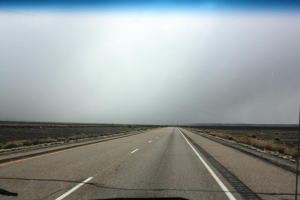
Miles and miles of plains ahead
Three o’clock PM. We’re loaded up, block ice in the cooler. Skye, Jordan, and I start a big adventure, my first road trip in decades! “Only for a good cause,” is my internal refrain. We’re psyched and apprehensive. There are a lot of plains out there.
First tour stop is Colorado and we’ve got plenty of time to get there. Today we’re hoping to reach Green River, Utah by 1 or 2 AM.
Ford Econoline, a stretch van. It’s ready to go, tires rotated, oil changed, brakes checked, same with all filters and fluids. Our spare is at the ready, new wiper blades. This “Super-Van” has the space to hold THE TON, all its and our gear, with a bench seat in addition to driver and copilot positions, and plenty of power to cross the Rockies.
Green River and on schedule. Good push complete with snow and icy conditions. Tough miles. No studs, just an experienced winter driver. Breakfast in Grand Junction, Colorado, then visiting the Crack in the Wall Gallery in Rifle. We soak at Glenwood Hot Springs, a chilly breeze. “Winter ain’t quit here.” Dinner in Aspen.
We’re up and on the road by 4:30 the next morning, bound for Boulder, and it’s snowing. Good news, Vail Pass is open. Hope so, we’re supposed to be at University of Colorado by 9:30 AM.
University of Colorado
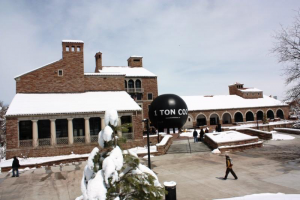
Snow won’t slow us down
Thursday in Boulder and the sun is shining. We’re just off Broadway; what a view of the Flat Irons. We shovel snow out of the way at the entrance to the Student Center. The Student Center and three other buildings are owned and operated by Student Government (formerly known as the Student Union) which operates with a $24 million annual budget paid by student fees. It also pays the utility bills on campus, and thus can use energy savings for greater good. The sun is intense, and soon steam rises and dries the courtyard for THE TON.
THE TON is prominent. We raise great interest, and help the university sign up students and faculty for the One Million Acts of Green online service. There you make pledges and calculate your footprint. A teacher from the elementary school across the way approaches us to get the scoop. She says everyone in the school has asked about the huge, black balloon. We’re interviewed by students, and uploaded within minutes.
Three PM, we pack quickly and head east. Time for a non-stop to be at Clark University in Worcester, Massachusetts by 10 AM on Saturday. We have three able drivers and a head of steam. Within an hour we’re out of the Front Range megalopolis, northeast on I-76 until we catch I-80 in the panhandle of Nebraska.
Eastbound on I-80
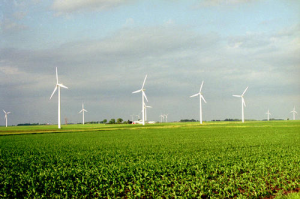
The wind farms in Iowa
We press on through Nebraska, then passing through the wind farms of Iowa at about midnight. Witness red lights steering clear aviation, the faint images of giant blades swooshing through the night. Bizarre and all around us. Passing through Windy Hills there are turbines on both sides of Interstate 80. Farmers here get $2,000 – 5,000 annual royalties per turbine depending on its size. Two sources of income from the same acreage.
Iowa is number three in wind power capacity after Texas and California, number one in terms of wind capacity per acre, and number one in terms of wind as a contribution to total electricity use with 24% in 2012. It’s windy in Iowa! And the turbines’ average capacity factor there is 33%. NREL estimates a 570,700 MW wind potential for the state. Iowa’s wind power capacity totaled 5,017 MW at the end of 2012, less than 1% of the potential.
With our Colorado adventure a clear success, we power through the night to get to Clark by Saturday. Great windshield time, singing along to some good old rock and roll. My first tiny sips of a 5-hour energy drink, wow!, and 32 hours later we arrive in Massachusetts. Time check and we book into a hotel. Love the shower! Some sleep, quick breakfast, and back on the Mass Pike and to get to Worcester on time.
Clark University
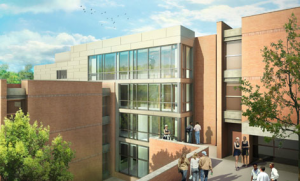
Johnson-Sanford Building goes LEED Silver
It’s hard not to notice the dominant wind turbine on the Worcester sky line. Then a Wal-Mart supercenter with 12 microturbines spinning atop 48-foot high light poles in its parking lot. These are financed and installed by Deerpath of Marblehead, MA. It did a similar installation at Sam’s Club in Palmdale, California. These highly visible units will cut the store’s power use by about 5%. We learn that Wal-Mart has questioned the economics of Cape Wind.
Clark University was founded in 1887 as the first all-graduate institution in the country. Today it is a liberal arts college with 2,250 undergrads and 1,120 graduate students, and a reputation as a small research university with a major impact. Clark has a carbon neutrality goal of 2030; its GHG emissions fell by 11% from 2011 to 2012 and now stand at 13,469 metric tonnes.
Clark is known for its progressive energy and environmental works. In 2013, and for the past three years, it was rated in the Princeton Review as one of the top-tier green colleges in America. It has 30 EcoReps, and a cogeneration plant now fueled with natural gas. The new Johnson-Sanford Student Center is LEED silver; 80% of its furniture has been recycled or repurposed.

A student band rocks out with THE TON
Clark is very green. Its vending machines are all Energy Star. Water filtration systems have been installed in all the dorms. It has Worcester’s first rain garden, to capture and filter rain water. Its Student Sustainability Fund funds a wide variety of green causes, from alternative menstrual products, to added recycling infrastructure, and expanding the Thrift Store.
EcoMotion fields a team of six in SAVE A TON black shirts. We work the crowd, handing out stress balls and engaging in the climate conversation, singing up students for the SAVE A TON pledge. Four Legged Faithful gives us signed CDs; then thrilled the crowd with their energy and talents. The second act, Big Tree, is from California and suggests a summer tour with THE TON and the climate protection message.
Millbrook University
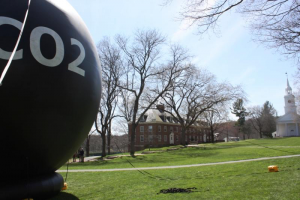
Millbrook’s Flagler Quad
Dutchess County, New York holds a special charge for me: My grandparents founded Millbrook School there in 1931, taking an old farm and turning it into a reputable prep school now well known, particularly for its community service philosophy and zoo. Yes, a zoo! Years ago a man with the last name Trevor arrived with a truckload of caged animals and convinced my grandfather that his new school needed a zoo. Today, it’s quite an attraction.
Millbrook is a small school with a big mission. It has 280 students and is committed to carbon neutrality by 2020. EcoMotion has been retained to help Millbrook develop its plan and maximize the value of its leadership. This past month we released a request for proposals to solar contractors for a solar system to power the entire campus. The array, combined with energy upgrades in dozens of buildings will constitute Phase 1 of a three-phase process.
We’re ready for the sun. It’s the height of spring in New England as we drive up School Road, the idyllic campus bathed in sunlight, students out throwing Frisbees, dogs romping, kids listening to music, soaking it in. They all get a kick watching us set up THE TON.
We inflate on Flagler Quad, in front of the School House and my grandfather’s office. What would he think? He retired long before the climate issue was evident, and always questioned my vegetarianism and use of the term “holistic.” But he took great pride in being progressive and open. Certainly a big believer in energy efficiency, he was aware of the greenhouse gas situation before he died, and I would like to think that he would salute our commitment to education and action. His successor Drew Casertano greets us warmly.
Sun shining on campus, classes winding down, the best of quad life. We talk to students about our mission, and our footprints, how they can reshape their generation’s impact. The school’s footprint is about 3,000 metric tonnes. Trees on its sprawling campus may absorb a third of this. I speak to teachers about the display, and what’s next. We agree that THE TON may have a limited shelf life. How soon will it be that the signs of climate change galvanize action?
Teacher Somerset Walker proposes a design competition between Brown and Millbrook students to reward a fresh idea for EcoMotion to communicate the climate issue. Another teacher contemplates means to incorporate THE TON in classroom activities, for math and physics students to calculate, for artists to draw, and poets to phrase… for each academic discipline to instill a deeper level connection with THE TON and its climate protection message.
Brown University on Earth Day

The Brown University homepage
Up early on Federal Hill, the Dolce Villa, then across the freeway to Brown.
The quad at Brown. Earth Day. Trees budding, sun shining, a perfect venue. There is a bit of a breeze; we anchor with four lines to major trees. THE TON is going nowhere! The bells ring to change classes. Facilities crews work the quad to clean up from Spring Weekend, getting ready for commencement.

Brown University EcoReps attempt to kick THE TON
Students, staff, even security officers take photo after photo. This is a curiosity. I invite my wave-energy friend Foerd to join us; so does Lucia Petty. I think of EcoMotion Intern Stephanie Olamendi who’s just been accepted to Brown for grad school. Three cheers.
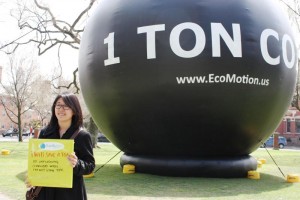
A Brown student with pledge to unplug electronics
Brown students pledge to SAVE A TON in all different ways. They clutch a small, dry-erase board with their commitment. Cold water washes, shorter showers, turning off lights, carpooling, community action. Photos are taken, all set for FaceBook.
There are lots of EcoReps here and on hand. A local popsicle maker sets up near our tables. We take breaks and throw Frisbees. Brown conducts a LED-trade in program: If you surrender an incandescent lamp, or CFL, you get a new GE LED! Good deal. We’re set up for five hours. THE TON ends up on the home page of the Brown University web site.
Messaging and Carbon Science
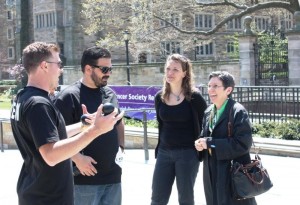
Our 32′ diameter TON = 1 atmosphere at 0 degrees Celsius
At each stop, THE TON serves as the ultimate conversation starter, and we have a rapp. “Do you know how many tonnes of greenhouse gases each of us is responsible for each year?” “One TON, two TONs,… 500 TONS?” For others, “Do you have any stress in your life?” We hand out stress balls in the form of THE TON.
Our carbon footprint does indeed vary, depending on the jurisdiction and the scopes included. The average U.S. citizen’s footprint in 2010 was 22 tons. The states with the smallest per capita footprints are New York (8.97 metric tonnes, MT), Vermont (9.64 MT), and California (9.96 MT).
Wyoming, at #33 in terms of emissions generated, is #1 in per capita emissions at 115 MT. North Dakota is at 72 MT per capita; Alaska is 54 MT. Critics note that these states both pollute the planet and benefit from cheap coal-fired power. Others claim that Wyoming’s energy resources are “feeding the rest of the nation.”
The states that are the biggest emitters are Texas (653,245 MT), California (370,890 MT), and Pennsylvania (253,699 MT). Texas emits twice that of the next two largest states. Big factors are coal-fired generation and oil and gas productions. Vermont emits the least overall GHG emissions: 6,034 MT.
Middlesex Community College
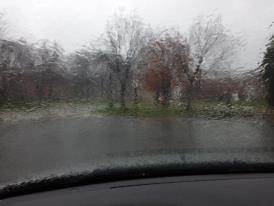
Wettest day of the tour
Rain, and more rain. It’s cold and miserable. We set up on a soggy grass area. Our hosts are apologetic and offer assistance. What a mess. Filling the water ballasts is miserable. Yet we press forward. This is about creating a successful tour, engaging students, building relationships, and a little rain won’t get in our way. We learn about Middlesex’s new geothermal system, a $325,000 investment to provide heating and cooling for the 9,800 square foot Trustees House.
Classes come out to see the display and I give each one a 10-minute briefing on the display and the global carbon situation. I talk troposphere and gigatons, the basic thirds of the anthropocentric side of the carbon imbalance. The students get it. We talk solutions.
Paying our dues this day. Too much water. We pack THE TON soaking wet and can barely get it into the van. We crank the heat on our feet and find a Whole Foods for lunch. Seitan salad and green machine for me. Then “home” with just enough time to change and warm up before dinner at the Charles Hotel with great friends. Time for Legal Seafoods.
Massachusettes Sustainable Communities
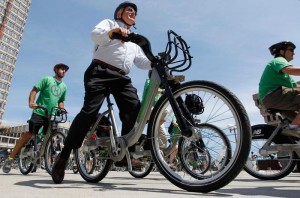
The Hubway bike sharing program in Boston
Day off so we register for the Third Annual Massachusetts Sustainability Conference at the DCU Center in Worcester. It’s merged with the Second Annual Sustainable Campuses conference, and the agenda is peppered with people we know.
As a Californian, I was surprised to hear that Massachusetts is now ranked number one for energy efficiency. And in 2008, the Commonwealth committed to reduce its greenhouse gas emissions by 25% below 1990 levels, a far steeper commitment than California’s AB 32 which calls for achieving 1990 levels by 2020.
The conference was about connections, perspectives and insights. Harvard’s green report card measures health and wellness, as well as community engagement. Jenny Isler has formed an affinity group of Worcester sustainability coordinators, “to sustain ourselves.” Newburyport’s Solarize campaign used a competitive bid for solar contractors to drive down costs using five tiers of pricing to benefit from increased economies of scale.
At Framingham State, NSTAR built a new gas line to the campus. Middlesex Community College installed a geothermal plant and is now looking at what student behavior can add to its savings and carbon footprint reduction. Clark’s composting program is dominated by paper products from the dorms. There, year-end drives resulted in 13.6 tons of clothes for donation, and nearly a ton of food redirected to the homeless. Gordon College gave all freshmen LED bulbs.
unConferencing
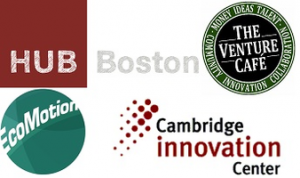 Cambridge’s first Sustainability unConference was sponsored by EcoMotion, the Cambridge Innovation Center (CIC), and the Venture Cafe. EcoMotion’s Director of Campus Services Sierra Flanigan opens up the conference with a warm welcome. “The rich diversity and intelligence of the participants at this unConference provide me with great optimism,” she stated.
Cambridge’s first Sustainability unConference was sponsored by EcoMotion, the Cambridge Innovation Center (CIC), and the Venture Cafe. EcoMotion’s Director of Campus Services Sierra Flanigan opens up the conference with a warm welcome. “The rich diversity and intelligence of the participants at this unConference provide me with great optimism,” she stated.Geoff Mamlet, Managing Director at the CIC and now #1 at Boston’s new HUB, adds welcomes and asks THE question: “How many of you have been to an unConference?” To my surprise, there is a smattering of hands. It’s a new format, pre-trend I dare say, designed to elicit creativity, enhanced networking, and real-time discussions. Sessions can pop up at any time. “If a session is not moving you, let your feet do the walking,” says Geoff.
With 250 attendees, twenty-one conference rooms on three floors are reserved; some sessions are small, others large. Topics sweep from food systems, to composting, energy, climate action in Cambridge, and more. Jim Newman talks Energy Districts; Bruce Fulford leads a session on urban composting. Thirteen unique sustainability exhibitors line the Venture Cafe.
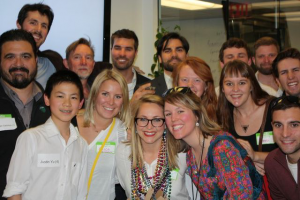
unConference volunteers
I lead a discussion on envisioning the renewable energy future. We begin with my supposition: Our renewable energy deployment is really very nascent. In the spirit, we fetch beers and brainstorm. What will the renewable energy future look like in 5, 10, 25, and 50 years? Building integrated PV? Micro-heat pumps in wall boards.
Distributed generation will no doubt be omnipresent. We talk about California’s bold net zero mandate, community solar, and utility-scale solar. Two participants work for Next Step Living, a growing New England-based company that offers residential services from basic household efficiency to solar investments.
Yale University
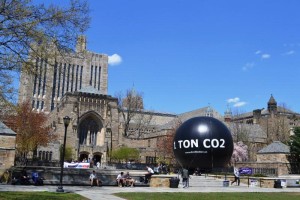
THE TON is at Sterling Memorial Library, can’t miss it!
What a thrill to be at Yale, and a postcard perfect spring day to boot!
It was a fortuitous path to Yale. Terry had girls night out, and after some woodworking, I was surfing the channels and came across Bill Moyers interviewing a Yale professor on climate change communications. Interested I was to find that Yale has a center for climate change communications. Anthony Leiserowitz was lamenting the fact that the issue is invisible. It’s so hard to make an impression and drive behavior. I sent him a photo of the THE TON and he immediately linked us with Amber Gerrard in the office of sustainability.
We not only got on campus, but we were welcome to set up in its best location, Cross Campus, where Bill and Hillary met in the fall of 1970. We’re cleared to set up in front of the Sterling Memorial Library, Yale’s largest and most prominent, containing over 4 million volumes on 15 levels. As we inflate, tons of questions and comments. In what has become the norm, student after student snap photos of THE TON. Top Yale officials welcome us.
Lisa Fernandez, Associate Director of the Yale Center for Climate Change Communication wrote afterwards that, “I consider the event highly successful. The evening of the day you were here I presented to a local group of environmental activists/conservationists (including Ted Jr. and Kiki Kennedy) and used a picture of your “ton of CO2″ as it bobbled in front of Yale’s Sterling Memorial Library. It’s truly a stunning visual and brings home what it means.”
Big Thanks!
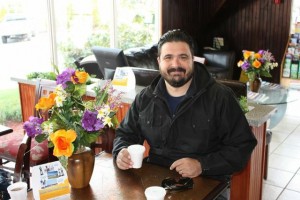
We could not have done it without Jordan!
EcoMotion appreciates the great interest in THE TON and the opportunity to bring our display to New England.
Thanks in particular to our campus contacts and champions: Bob Pion, Susan Michelle Beckett, Dave Newport, Jenny Isler, Jane Meigs, Anna Poon, Kai Morrell, Matt Supe, Rob Gogan, Tony Leiserowitz, Lisa Fernandez, and Amber Gerrard. These individuals made possible the tour a reality.
Thousands of photos taken on campuses proved one thing, it is incredibly eye-catching. At Brown, an EcoRep called THE TON “the ultimate conversation starter.”
Thanks in particular to Jordan Garbayo for serving as project manager coast to coast, and to staff – Drew (west-bound driver), Sierra, Russ, and Maria for their roles making it happen. Skye not only flew west to drive east but also did outreach at every tour location. We all celebrated with a Red Sox game at Fenway.
Family and friends supported us along the tour: Terry, Chris, Mike, Rosemary, Bill, Kathy, Helen, Erica, Mark, Morgan, Ben, and Yael; clearance for a multi-week, 7,188 mile experience. Our tour sponsor insisted that we persist in the aftermath of the heinous Marathon bombing, and we’re glad we did. We’d like to think that we have been part of the light that surrounds Boston in its healing process.
THE TON is a magnet, it creates teachable moments, and the SAVE A TON campaign resonates. It was by all accounts a highly successful tour. It took a lot of energy, but we touched thousands directly, and likely tens if not hundreds of thousands indirectly through the press and social media. Sure, we’ve been invited back to Brown, Colorado University, Millbrook, Harvard, Boston College, and Boston University. It gives us great pleasure, THE TON is really instrumental.
